
Candida Martinelli's Italophile Site

Main
Page This family-friendly site celebrates Italian culture for the enjoyment of children and
adults. Site-Overview
Quick Link:
Basic Pasta Recipe Below
Pasta in Italy is a generic term for the
durum wheat dough that Italians boil and serve with sauce or oil
or butter or in soup. Pasta is a staple of the Italian diet. It's
served as a first course, in portions much smaller than those eaten
outside of Italy. There is even a
patriotic tri-colore
(tri-color of white, red and green the colors of the Italian flag) dish that some people serve on patriotic occasions.
Three colors of tagliatelle (or
other colored pasta) are prepared, and then
they are seasoned with three different colors of sauces.
For example, on the serving dish you would see white pasta with
tomato sauce, the green pasta with white sauce (besciamella),
and the red pasta with a green sauce (pesto).
Tomato
or Beet juice
is added to pasta to make red pasta.
Spinach is added to make green pasta.
Squid ink is added to make past black.
Tumeric or
saffron is added to make pasta yellow. An odd fact: It's even cooked for pets
in Italy, as pet food, purchased from pet shops. There are two categories of pasta: pasta asciutta (dried pasta) can be
stored for years without going bad, but requires a longer cooking
time than fresh pasta pasta fresca (fresh pasta) has a very
short cooking time, but it cannot be stored for very long before
going bad Fusoli (from Laporta)
Fusili (rifles from Laporta)
The
history in Italy of pasta cooked and seasoned with a sauce can
be traced as far back as the Etruscans (900 B.C.) who seasoned their
pasta with game (venison) based sauces.
The
story of pasta coming from China is a myth.
Mparrettati (from Laporta)
Filei (from Laporta)
Maccheroni (from Laporta)
This passed on to the Romans and then appears in the
first
Italian cookbook in Italian, rather than Latin, by Anonimo Toscano,
from the end of the 1300’s, and published for the first time in 1963
by Francesco Zambrini. (I have a page about Ancient Italian
Cookbooks. It's about three cookbooks that were written from
1380 to 1500.) Ravioli (raffioli) are mentioned in Anonimo Tocano's early
cookbook, and the recipe is repeated in the later books.
The ravioli (the dough made with flour and water) are filled with all kinds of things,
both sweet and savory (often a mincemeat),
and either boiled in broth or fried, and sometimes topped with sugar.
Today in Italy ravioli is also used as a generic term for a
filled pasta.
Lasagna shows up early too, and is just a flat thin pasta of
flour and water cooked in broth and topped with
extra animal fat for good measure. But there is an early
recipe for a baked dish that layers a crust or pasta (pastello)
with other ingredients, which resembles today's
lasagna.
Maestro
Martino’s De arte coquinaria from 1450 has recipes for vermicelli
and maccheroni.
Tagliatelle: Martino calls it maccaroni
romaneschi, but it is the same as today's tagliatelle, even to
the point of telling us we can cook them in the nest form or
separated into string form. The pasta is rolled around a
bastone, club, which today in Italian is called a matarello,
the the rolling pin is removed and the pasta is cut. He says
to cook it in broth or water, then serve it seasoned with butter,
cheese and sweet spice mix. Interestingly, today in Italy you
can buy a tagliatelle that is twisted, and called maccheroni.
And in Italy maccheroni is used as a generic term for pasta. Tagliatelle (from Laporta)
Spaghetti: Martino calls this triti or
formentine, but as described it is recognizable as today's
spaghetti or linguini. He says to make it like the
tagliatelle, but cut it much thinner. It's served up the same
as tagliatelle. Spighetti (from Laporta)
Bucatoni: Martino call them maccaroni siciliani,
and explains that you make a flour pasta that includes egg white and
rose water. Then you roll strips
of the pasta
as long as your hand, around a wire as thick as a piece of straw (spagho),
then remove the wire. This makes a thick, hollow pasta that
today is called generally bucatoni (or bucati). He says to dry them in the
sun. I actually call them fire-hoses, because that is what
they remind me of. They are very heavy, and need to be cooked
a long time, but perhaps not the 2 hours that Martino recommends!
Vermicelli: This soup pasta is the same as today's
soup pasta called vermicelli (little worms, or larvae).
Martino says to cook them for 1 hours, and to color the dish yellow
with saffron, unless you cooked them in milk.
Pater Nostri (Our Fathers from Laporta)
Ruote (wheels from Laporta)
The
earliest seasonings for the cooked pasta were meat sauces, milk,
butter, cheese, vegetables, and only after the arrival of the tomato
from the New World, and then some time to be convinced it wasn’t
poisonous, did tomato find it’s ideal partner in pasta.
Practically every family in Italy has a favorite sugo or
salsa for their pasta, so I won’t waste time putting one
here. (I provide a link
below to a recipe site with lots of
sauce recipes.)
But I will put a
recipe for an older pasta sauce, originally Italian (with some
variation in ingredients) and now considered French:
La besciamella (white sauce).
The De' Medici called it colla, which means glue, and when
it cools it is very glue-like, but when it is warm it makes a rich and
exotic pasta sauce.
Maniconi (from Laporta)
Paccheri (from Laporta)
La
besciamella
- Béchamel or White Sauce 50
grams of butter 4
tablespoons of white flour ½
liter of milk or chicken broth (milk for vegetable pastas, half/half
for meat and fish pastas) 50
grams of grated Parmesan cheese Salt
to taste Grated
nutmeg
Most
recipes have you melt the butter, then add the flour, and then slowly
whisk in the hot liquid. I
find that unnecessarily laborious and too often end up with balls of
flour. I never have a
problem when I start with cold liquid, whisk in the flour, then heat
it up slowly, whisking as it cooks.
After a low boil, whisking continually, for about 5 minutes, it
is usually ready. Remove
it from the heat and add the butter and cheese and stir until they
melt. Then add the salt
and nutmeg to taste. To
give you an idea of how much nutmeg you might use, I like a lot of
nutmeg, which usually means about ½ a teaspoon. Gigli (from Laporta)
Gnocchietti (from Laporta)
Orecchietti (from Laporta)
Fresh
pasta is made in sheets and cut and shaped in the various types of
pasta.
To
make fresh pasta at home, one must have:
a pasta machine to create the
sheets, (this is not a necessity, but your pasta will generally be
thicker without one unless you are very strong and have lots of
experience and patience)
a rolling board, (or marble counter, or floured
tabletop)
a rolling pin, (the Italian matarello is
ideal for pasta making because it is 3 times as long as a pie crust
rolling pin)
patience,
patience
and more
patience.
And as with all
artistry, practice makes perfect.
250 grams sifted flour
2 eggs
1 teaspoon oil
1/2 teaspoon salt
Sift the flour into a mountain on your work surface. Make a bowl
shape in the middle of the mountain.
Put the rest of the ingredients in the 'bowl'. Mix it all together
with your fingertips, then your hands until you have a firm ball of
pasta dough.
Add flour a bit at a time until the dough is dry enough to roll out.
If you have a small rolling pin, it is best to divide the dough in two,
and work each section separately. Roll out the dough into a thin
sheet.
To make tagliatelle, lightly flour the sheet, then fold it up
accordion style. With a large, sharp knife, slice the roll up into
tagliatelle-wide strips.
Gently shake out the strips into the tagliatelle strands.
Set them on a floured board or tray. Cover them with a kitchen
towel and let them dry a bit until you are ready to cook them.
Fresh pasta cooks very quickly, so stand ready to remove the pasta from
the boiling, salted water, and put on the sauce or seasonings, and serve
it immediately.
Then accept the raves with grace and humility.
Here is a recipe that is a bit easier, called Gnocchi
di spinaci or malfatti alla fiorentina. It requires
none of those things listed above. It
is typically served during Lent. (I provide a link
below to a page with a good, brief
summary of pasta making.)
Gnocchi
di spinaci / malfatti alla
fiorentina - Spinach Gnocchi / Florentine Misshapen Things 1 kilo freshly cooked spinach, all moisture removed, chopped finely 500 grams of fresh ricotta cheese 200 grams of grated Parmesan cheese 2 large eggs, or 3 small ones Ground nutmeg (1/2 teaspoon or so) Salt to taste
Mix
together the chopped spinach, cheeses, eggs, nutmeg and salt.
Shape small balls of the pasta, then lightly flour them.
Cook them in boiling water until they float.
Remove them and season them immediately and serve.
A simple seasoning is best, like melted butter with some sage
and Parmesan cheese. But
you can use a tomato sauce if you prefer. Trofie (from Laporta)
Casarecce (from Laporta)
Penne
are thick tubes of pasta about as long as your thumb.
They are as much a staple of Italian pasta as spaghetti.
They hold up well to strong flavors and retain their chewy
texture even when not served immediately.
Men seem to love this type of pasta, and to prefer it over spaghetti.
Cook them according to the instructions on the package, which
should indicate the number of minutes they should be boiled in salted
water. Mezze penne (Rigate)
Penne (from Laporta)
Pennoni (from Laporta)
Some Penne Variations:
Cream
and Ham Sauce:
Melt a few tablespoons of butter in a pot over a medium heat,
then add fresh cream and let it evaporate a bit on a high heat for at
least 5 minutes.
Add
diced cooked ham,
the cooked Penne,
grated Parmesan cheese,
salt and pepper to taste.
Let
it cook just a few minutes more, stirring continually.
Adjust the amounts of cream and ham to suit your personal
tastes and the amount of pasta the sauce is to cover.
Cream,
Ham and Pea Sauce:
Cook the sauce as described above.
When you add the cooked Penne, add cooked peas to the
sauce as well.
Cream,
Garlic and Mushroom Sauce:
Melt a few tablespoons of butter in a pot over a low heat and
add chopped garlic cloves to personal taste.
Cook for a few minutes, then add fresh cream and let it
evaporate a bit on a high heat for at least 5 minutes.
Add chopped, sautéed mushrooms
and the cooked Penne,
and season with salt and pepper to taste.
Let it cook just a few minutes more, stirring continually.
Adjust the ingredient amounts according to your personal tastes
and the amount of pasta the sauce is to cover. Lumaconi (big snails from Laporta)
Just
one last word, concerning the cold-water-on-cooked-pasta debate:
One cup of
cold water thrown over just cooked pasta, works well as a break on
cooking, long enough to get the pasta seasoned and served up at table.
But you should never rinse the cooked pasta under running water
because you lose the flour-water coating that has formed over the
pasta, which helps the seasonings cling to it. Conchiglie (shells from Laporta)
A simple
overview of pasta making Festosi (celebrations from Laporta)
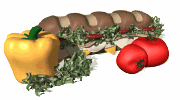
Pasta
![]()

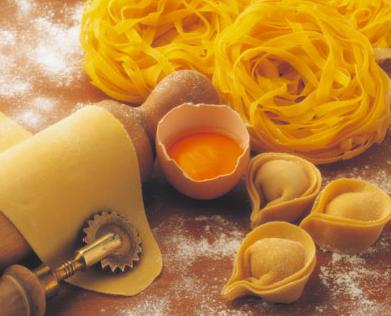
Pasta
Introduction


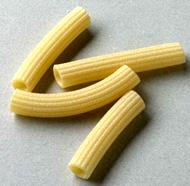
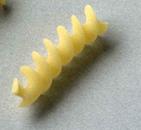
Pasta History


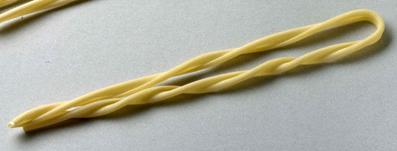

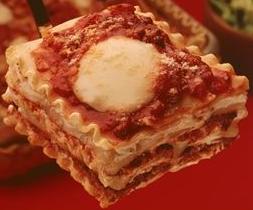
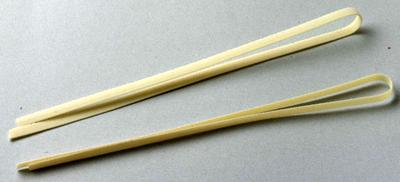
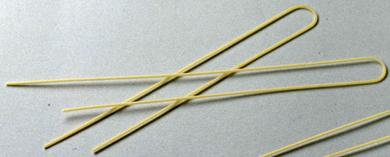
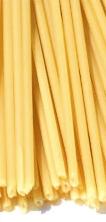

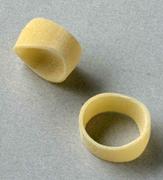

Pasta Sauces

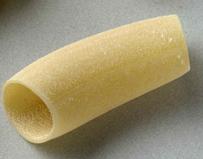
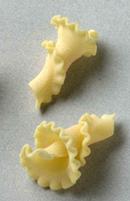

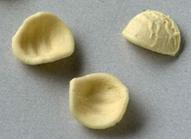
Fresh Pasta
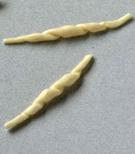
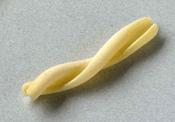
Le
Penne
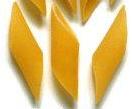
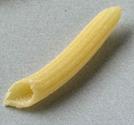
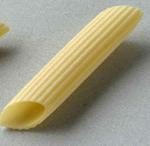
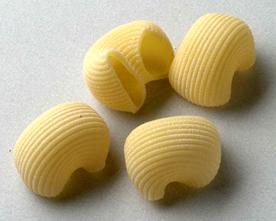
Pasta Tip
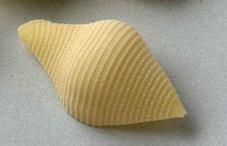
Links to Pasta Sites
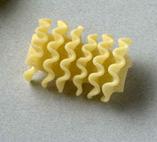
Pasta Cookbooks from Amazon
(and Machines)

![]()
![]()